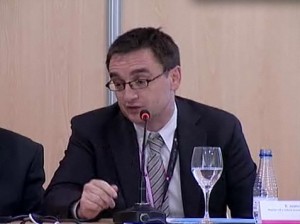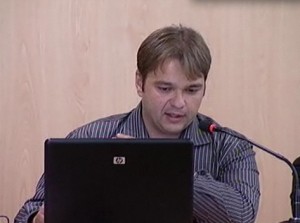Respaldo decidido de las autonómicas a la alta definición
Mientras que en junio 2009 había solo tres autonómicas emitiendo en HD, un años después son nueve las que ya emiten en pruebas en HD con intención de emitir cada vez más contenidos HD nativos. Los directivos técnicos de las autonómicas españolas analizan en las Jornadas TDT-HD en SICARM 2010 en Murcia la situación actual del despegue de la alta definición quedando constatado el decidido respaldo a la HD por parte de, al menos, los cuadros técnicos de las autonómicas.
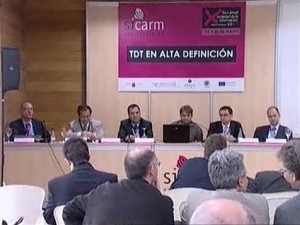 Coincidiendo con las Jornadas sobre TDT en HD que se celebran este miércoles y jueves en el Auditorio y Centro de Congresos de Murcia, en el marco de SICARM 2010, los responsables técnicos de las autonómicas han mostrado su firme apuesta por la alta definición habiendo emprendido proyectos tanto en generación de contenidos, como en la investigación y puesta en marcha de sistemas de emisión.
Coincidiendo con las Jornadas sobre TDT en HD que se celebran este miércoles y jueves en el Auditorio y Centro de Congresos de Murcia, en el marco de SICARM 2010, los responsables técnicos de las autonómicas han mostrado su firme apuesta por la alta definición habiendo emprendido proyectos tanto en generación de contenidos, como en la investigación y puesta en marcha de sistemas de emisión.
Tal y como se encargó de recordar el director de negocio en Abertis Telecom, Oriol Sitjà, la HD en el marco autonómico va a dos velocidades entre aquellas que disponen de un múltiplex completo para emisión en HD, y las autonómicas que tienen que compartirlo, de momento, con operadores privados. Esto condiciona, lógicamente, la elección entre una multiplexación estadística o utilizar únicamente el bitrate que les corresponda. Sitjà se ha mostrado confiado en que la cifra actual de tres millones de televisores listos para recibir señales TDT-HD se ampliará a siete antes de que acabe el año.
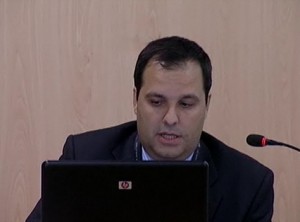 Diego Lorenzo, director técnico de RTRM-7RM ha comentado que 7 Región de Murcia comenzó sus emisiones en pruebas en alta definición en agosto de 2009 emitiendo en zonas muy restringidas de la Comunidad. Este año, una vez se ha procedido al apagón, emiten a través del canal 29 a toda la región ampliando la cobertura a los grandes núcleos poblacionales de Murcia, Cartagena y Lorca. RTRM utiliza una multiplexación estadística, empleando para la emisión convencional en SD unos 5 Mbps, y entre 8 y 11 Mbps para el canal HD. Para los interactivos, entre los que destaca el teletexto digital y el servicio de radio, dedican únicamente 1,5 Mbps. En los últimos meses, la autonómica murciana ha invertido en cámaras y ha renovado matrices y monitorización poniendo en marcha una nueva continuidad para ingesta y playout en HD.
Diego Lorenzo, director técnico de RTRM-7RM ha comentado que 7 Región de Murcia comenzó sus emisiones en pruebas en alta definición en agosto de 2009 emitiendo en zonas muy restringidas de la Comunidad. Este año, una vez se ha procedido al apagón, emiten a través del canal 29 a toda la región ampliando la cobertura a los grandes núcleos poblacionales de Murcia, Cartagena y Lorca. RTRM utiliza una multiplexación estadística, empleando para la emisión convencional en SD unos 5 Mbps, y entre 8 y 11 Mbps para el canal HD. Para los interactivos, entre los que destaca el teletexto digital y el servicio de radio, dedican únicamente 1,5 Mbps. En los últimos meses, la autonómica murciana ha invertido en cámaras y ha renovado matrices y monitorización poniendo en marcha una nueva continuidad para ingesta y playout en HD.
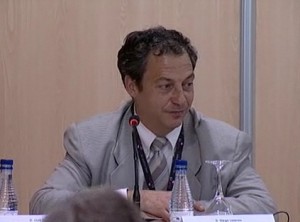 Por parte de la autonómica decana en la emisión en pruebas en HD, TV3, Lluís Grau ha destacado que desde el departamento de ingeniería se apostó fuerte desde primer momento por la alta definición. Entre abril de 2007 y julio de 2008 estuvieron emitiendo una señal HD en pruebas, que tuvo que desaparecer al ponerse en marcha el convenio de reciprocidad con Canal 9 cuya emisión ocupaba el canal destinado a esta experiencia. Durante «esta época oscura», como la ha calificado Grau, TV3 continuó con sus pruebas de forma interna, volviendo en junio de 2009 al aire. En este momento, disponen de dos múltiplex dedicando a los canales SD entre 2 y 4 Mbps y entre 6 y 16 para el HD. Esta emisión se cubría en la primera etapa desde Collserola, alcanzando una audiencia de más del 80% de la población, correspondiente principalmente al área de Barcelona. Desde enero de este año, emiten ya desde los cuatro centros principales que cubren Cataluña con un porcentaje muy alto de cobertura.
Por parte de la autonómica decana en la emisión en pruebas en HD, TV3, Lluís Grau ha destacado que desde el departamento de ingeniería se apostó fuerte desde primer momento por la alta definición. Entre abril de 2007 y julio de 2008 estuvieron emitiendo una señal HD en pruebas, que tuvo que desaparecer al ponerse en marcha el convenio de reciprocidad con Canal 9 cuya emisión ocupaba el canal destinado a esta experiencia. Durante «esta época oscura», como la ha calificado Grau, TV3 continuó con sus pruebas de forma interna, volviendo en junio de 2009 al aire. En este momento, disponen de dos múltiplex dedicando a los canales SD entre 2 y 4 Mbps y entre 6 y 16 para el HD. Esta emisión se cubría en la primera etapa desde Collserola, alcanzando una audiencia de más del 80% de la población, correspondiente principalmente al área de Barcelona. Desde enero de este año, emiten ya desde los cuatro centros principales que cubren Cataluña con un porcentaje muy alto de cobertura.
Televisió de Catalunya cuenta en la actualidad con dos estudios HD completos (desde uno de ellos se produce una serie diaria) así como con una móvil pequeña (con 6 cámaras), una ligera (2 cámaras + 1), y cuatro unidades autónomas. Toda la cadena de producción y automatización y archivo (Digition) está preparada para HD.
En cuanto a formatos, Grau ha destacado que aunque han probado tanto a 1080 como a 720, finalmente se decantaron por 1080i a 25 ya que hay más material en este formato evitando así la transcodificación. Grau ha hecho hincapié en que cuando TV3 comenzó sus emisiones en HD las propias Matrox, por ejemplo, no contaban con drivers para 720p, resaltando incluso problemas al trabajar con material a 50 frames en lugar de 25 llegándose a perder el propio time code. Aún así, Lluís Grau ha reconocido que desde su experiencia el «720p es más eficaz en ancho de banda para deportes, pero no hay tanto material en este formato».
TV3 emite en su canal en HD un carrusel de unas ocho horas diarias con un par de películas, información meteorológica que se genera en HD automáticamente (Activa Multimèdia), clips de promoción, eventos deportivos en diferido… renovándose la programación cada 8-10 días. A corto plazo quieren poner en marcha un simulcast con el canal principal TV3, aunque están esperando a tener un poco más de material para no tener que acudir al doblado de líneas.
Juancho G. Barrecheguren, director I+D y nuevos proyectos de las Corporación Aragonesa de Radio y Televisión, ha hehco un recorrido por algunas de las pruebas en HD llevadas a cabo en Aragón, reconociendo «el gran apoyo prestado por los técnicos y equipos de TV3». Cuando TV3 dejó de emitir en HD, en esa época que Grau ha calificado de oscura, Aragón aprovechó para tomar el relevo en estas experiencias pioneras poniendo en marcha el laboratorio HDLab. En 2008, empezaron a emitir producciones en bucle con un mix de contenidos y parrilla. De momento, no tienen previsto poner en marcha una emisión en simulcast, sino convertir su emisión HD en el segundo canal con un concepto de redifusiones culturales del primer canal en HD nativos, lo que esté disponible, o con up converter de SD. Incluso, han comenzado a producir en HD algunos documentales. Aragón tiene previsto poner en marcha un centro nacional de experimentaciones audiovisuales y de tecnologías en el que se hará especial hincapié en el desarrollo de la alta definición y el 3D. Además, en 2011 pretenden impulsar un festival de nuevas nuevas tecnologías en el mundo audiovisual dirigido al gran público, heredero de lo que fue en su día el Digitea.
Por lo que a formatos se refiere, según su experiencia «no hay diferencias subjetivas entre 1080 y 720, pero la gente de la calle psicológicamente piden 1080 porque lo asocian con más calidad. El progresivo en 1080 será el estándar del futuro».
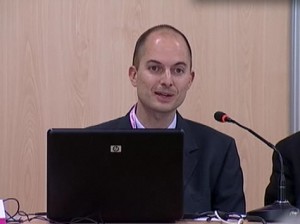 Vicente Pla, jefe de la Unidad de Red en TVV-Canal 9, ha reseñado que en este momento comparten en su primer múltiplex con dos privadas, habiendo solicitado pruebas en el segundo múltiples 32 para Valencia metropolitana. Canal 9 emite en su canal en pruebas en alta definición tanto contenido HD nativo como mucha programación hinchada desde SD. Pla ha comentado que si bien la calidad no es perfecta, están bastante satisfechos, aunque el principal escollo es el formato 4:3 del material SD. Uno de los aspectos en los que está experimentando la autonómica valenciana es la distribución IP en una experiencia en la que participan Sapec, otorola, Cisco, GVG, Ericson en las pruebas mientras que fabricantes de pantallas y decos como Arcelik, Sony, Panasonic, Engel o Tecatel comprueban las compatibilidades.
Vicente Pla, jefe de la Unidad de Red en TVV-Canal 9, ha reseñado que en este momento comparten en su primer múltiplex con dos privadas, habiendo solicitado pruebas en el segundo múltiples 32 para Valencia metropolitana. Canal 9 emite en su canal en pruebas en alta definición tanto contenido HD nativo como mucha programación hinchada desde SD. Pla ha comentado que si bien la calidad no es perfecta, están bastante satisfechos, aunque el principal escollo es el formato 4:3 del material SD. Uno de los aspectos en los que está experimentando la autonómica valenciana es la distribución IP en una experiencia en la que participan Sapec, otorola, Cisco, GVG, Ericson en las pruebas mientras que fabricantes de pantallas y decos como Arcelik, Sony, Panasonic, Engel o Tecatel comprueban las compatibilidades.
Enrique Mondelo, jefe del área audiovisual en RTPA, ha confirmado que Asturias apostó en un primer momento por alquilar equipamiento técnico y una móvil de ocho cámaras, con un mezclador HD y un servidor EVS para lanzar clips con grabaciones que se habían hecho por Asturias. Para esta primera experiencia Abertis prestó una cabecera con codificación HD y Localia cedió ancho de banda…. se emitía H264 a 9 Mbps en toda Asturias. Al no contar con equipamiento propio, concluyeron esta primera experiencia.
Este año RTPA ha adquirido una cabecera con codificadores HD y al desaparecer Localia utilizan el ancho de banda que utilizaban ellos más la cuarta parte del múltiplex que no estaba asisgnado en Asturias, con multiplexación estadística. Han montado además una continuidad HD, un videoservidor para emitir las películas y series en HD (la FORTA ha firmado un acuerdo general para dotar a sus autonómicas de contenido HD), y un up converter para experimentar con contenidos SD. También se ha invertido en monitorado y pantallas HD. Su intención, según Enrique Mondelo, es poner en marcha un bucle con emisión HD para empezar a provocar que la gente que tenga televisores HD Ready comiencen a disfrutar contenidos.
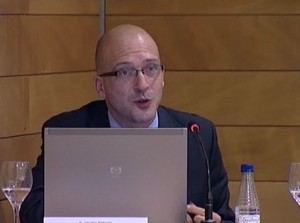 Jacobo Palazón, director técnico y explotación de Radiotelevisió de les Illes Balers, ha cerrado la ronda de intervención de representantes de las autonómicas asegurando que «hace año éramos muy pesimistas, ahora estamos ilusionados con los resultados en HD de emisiones como la Champion League. El apagón, que en el caso de Baleares se adelantó, provocó que IB3 añadiera valor». El pasado mes de marzo firmaron un convenio con Abertis para contar con una cabecera HD para emisión en pruebas en el canal 65, con gran cobertura en Baleares con 45 centros, cubriendo prácticamente todo el territorio (compresión a 9 Mbps). También han adaptado su continuidad, adquiriendo nuevo equipamiento HD, esperando a partir de otoño contar con una emisión en simulcast SD-HD en 16:9.
Jacobo Palazón, director técnico y explotación de Radiotelevisió de les Illes Balers, ha cerrado la ronda de intervención de representantes de las autonómicas asegurando que «hace año éramos muy pesimistas, ahora estamos ilusionados con los resultados en HD de emisiones como la Champion League. El apagón, que en el caso de Baleares se adelantó, provocó que IB3 añadiera valor». El pasado mes de marzo firmaron un convenio con Abertis para contar con una cabecera HD para emisión en pruebas en el canal 65, con gran cobertura en Baleares con 45 centros, cubriendo prácticamente todo el territorio (compresión a 9 Mbps). También han adaptado su continuidad, adquiriendo nuevo equipamiento HD, esperando a partir de otoño contar con una emisión en simulcast SD-HD en 16:9.
Los directivos de las autonómicas han concluido su intervención en esta jornada afirmando que la falta de regulación en la venta de televisores ha llevado a una confusión generalizada entre los consumidores al comprobar que no pueden acceder a la emisión en HD por no contar con un aparato HD Ready.
Por último, destacar que mientras que en junio 2009 había solo tres autonómicas emitiendo en HD, un años después son nueve las que ya emiten en pruebas en HD con intención de emitir cada vez más contenidos HD nativos.
La Jornada sobre TDT HD en directo
Desde Panorama Audiovisual podrás seguir las principales ponencias y mesas redondas que se celebren durante esta Jornada, clicando sobre el título de cada actividad.
JUEVES, 20 DE MAYO
- 10:30
INSTALACIÓN DE ALTA DEFINICIÓN EN EL TEATRO REAL DE MADRID
Jorge de la Torre Sánchez-Bravo. Delatorre- Teatro Real
- 11:00
PROYECTO AVANZA TDT-HD
Laura San Nicolás. Directora Técnica CARTV
Emiliano Bernues. Director Aragón Telecom
- 12:00
PRODUCCIÓN DE UNA SERIE DIARIA EN HD
Ramón Sangrá. Jefe de Explotación del Centro de Producción de Audiovisuales de TVC-TV3
- 12:45
DOCUMENTALES HISTÓRICOS EN ALTA DEFINICIÓN
Alfonso García, Fundación Integra.
Joaquín Ruipérez, Productora EstudioFuture
- 13:15
PRODUCCIÓN EN 3D
César Marruedo, Director técnico de 3D Integral y partner oficial de Epson España
- 16:30
CODIFICACIÓN DE VÍDEO EN PRODUCCIÓN EN HD
Darío Martín. Jefe de área de Sistemas RTPA.
- 16:50
AUDIO MULTICANAL. DOLBY DIGITAL PLUS (E-AC3), MPEG4 AACPLUS V2 (HE-AAC V2)…
José Javier López Monfort. Universidad Politécnica de Valencia
- 17:10
EMISIÓN EN HD
Vicente Pla. Jefe de la Unidad de Red TVV-Canal9
- 18:00
RECEPCIÓN EN TDT HD
Daniel Isus, Director Comercial Engel Axil
Mª Jesús Ranguil, Directora de Producto de Gigaset
Justo Rodal Pérez. Director I+D de Televés
Constantino Barber. Director de I+D+I de Tecatel
- 19:00
CLAUSURA PLENARIA
Luis Martínez Atienza. Secretario General de la Consejería de Economía y Hacienda de la CARM
¿Te gustó este artículo?
Suscríbete a nuestro NEWSLETTER y no te perderás nada.



